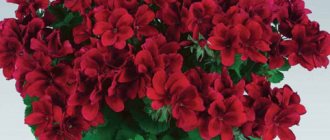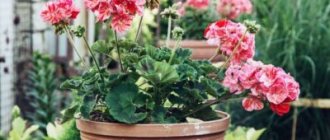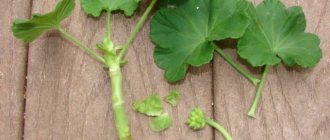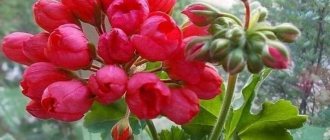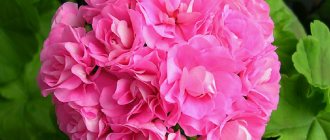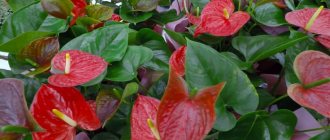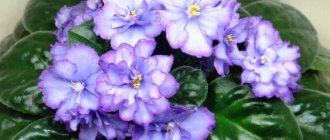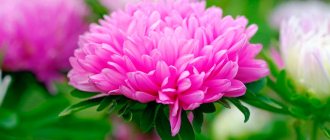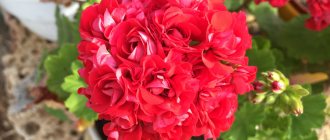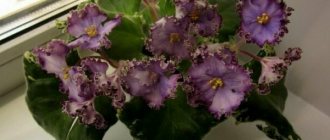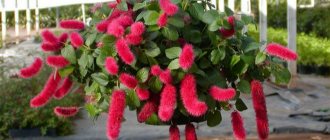History of the zonal species
Geranium of the genus Pelargonium zonalis was first discovered in the middle of the last millennium on the African continent.
The plant attracted the discoverers with its bright flowers and unusual box shape. This shape resembled the beak of a stork, which is why the new species was given the name Pelargoniums - a derivative of the Greek "πελαργός", which means "stork". And the word “zonal” appeared in the name due to the special color of the leaf plate - in spring and summer a small zone appears on it, painted in a different color. Thus, the Latin name for zonal geranium was formed - Zonal pelargoniums. For the first time, zonal pelargonium came to Europe from Africa in the 18th century - it was brought by British sailors to their homeland. There the flower gained wide popularity and until the beginning of the twentieth century remained a symbol not only of the Victorian era, but also of English bourgeois life in general. At the time when the popularity of the plant in the British Isles began to decline, zonal geranium was already known throughout Eurasia, thanks to which its old varieties were actively bred and new ones were developed.
To date, more than 350 varieties of Zonal pelargoniums are known. The flower is grown both indoors and outdoors, and the variety of colors allows you to choose a crop option to suit every taste.
Pelargonium Knight Salmon - description of varieties of the Salmon series
Among the variety of indoor plants, flowering varieties are especially popular among gardeners. A place of honor in this list is occupied by pelargoniums, which are better known to ordinary people under the name “geranium”. Breeders have developed many varieties with very different colors and shapes of inflorescences. Thanks to the work of German scientists, a whole group of Salmon varieties has appeared, all of whose representatives are so decorative that they definitely deserve attention.
Pelargonium belongs to the Geraniaceae family. The birthplace of the flower is South Africa. The name of the plant comes from the word pelargos, which means crane in Greek. And indeed, after the end of flowering, the overgrown column of the pistil resembles the beak of a crane. Externally, all varieties are similar and have some common characteristics.
Appearance and characteristics of pelargoniums
Description
An adult pelargonium plant is a herbaceous perennial with beautiful pubescent leaves and simple or double flowers collected in inflorescences.
The leaves differ in shape and color depending on the variety. The leaf color of most varieties is dark or light green. Some new varieties, for example representatives of the Salmon group, have a darker leaf color with pronounced veins. Sometimes there is a brown or burgundy edging along the ribbed edge.
Flowers can be single or double. In all varieties they are collected in umbrella inflorescences. The color of the petals can be very diverse - from snow-white to dark burgundy.
For reference! In some varieties of pelargonium, the color may have two colors at once, usually one color is in the middle of the flower, and the second is present on the rest of the petals.
Methods for propagating a flower, when is it best to do it
It is recommended to propagate the plant by cuttings. This is the simplest and most affordable option, which allows you to preserve the varietal characteristics of the crop. With the seed propagation method, it will not be possible to achieve the required results.
To carry out cuttings you need to do the following:
- Cut off the apical shoot from the mother bush. Its length should be 7 cm.
- The shoot needs to be dried for 8-10 hours - to do this, it should be wrapped in paper.
- Then place the cutting in a glass with soil.
- After 10-20 days the shoot forms roots.
You can also grow the root system in water. However, this method does not speed up the rooting of shoots. In addition, the liquid can lead to rotting of the stem, so this method is not usually used.
Important! In order for the plant to take root faster, it should be placed on a lighted windowsill. Systematic watering is important
Landing rules
Planting activities should be carried out in mid-April or early May. At this time, the earth will already be completely warmed up. It is better to purchase planting material in specialized stores, because this is the only way to be sure of the quality of the products. Pelargonium Salmon seeds are quite large, so before planting, lightly rub them with fine sandpaper. This will be their scarification.
The planting process has its own characteristics:
- Prepare a wooden box and fill it with nutrient soil. The store-bought option is perfect for these purposes.
- Make grooves, placing them at a distance of 2-3 cm.
- Distribute the seeds maintaining a distance of 1.5 cm, lowering them to a depth of 1 cm. There is no need to sprinkle with soil, but simply cover the seedlings with film.
- They appear on days 14-20. And as soon as they form 2 leaves, they can be transplanted into containers with a diameter of up to 10 cm. The soil can be used the same as for growing seedlings.
- Pour soil up to the edges of the pot and make a depression in the center. When planting seedlings freely, it is much easier and more convenient to handle the plant.
Pelargonium Salmon: features of care and cultivation
Pelargonium Salmon is one of the most successful varieties for home cultivation, which can boast not only of unique unpretentiousness, but also excellent decorative qualities. In this article we will study the main features of Salmon pelargoniums and learn about the basic rules for caring for them.
Varieties of the Salmon group
The Salmon group is represented by a wide variety of varieties, among which you can find both zonal and royal pelargoniums.
Bulls Eye
This geranium is designed for professional cultivation. It will adequately decorate the terraces of prestigious cafes and restaurants, flower beds of large public institutions on the central streets of cities.
It has dense elastic leaves. Bright pink large ball-inflorescences on low fleshy peduncles reach 15 cm in diameter. The height of the plant is almost 40 cm. The stems are powerful, large, and are not afraid of bad weather.
The variety looks very presentable in tall powerful flowerpots. The plant grows voluminous and lush. You can plant it in a home flower garden, in a spacious, well-lit place where there will be no direct burning rays of the sun.
Mephisto F1 Salmon
A wonderful professional zonal variety. Height – 35 cm. The shoots are strong, branch well, forming a beautiful spreading bush. The leaves of the plant are round, chocolate-colored, with a bright green edge and an elegant wavy edge. The inflorescences are dense, uniform, and come in various colors:
- Mephisto F1 Scarlet – juicy red inflorescences;
- Mephisto F1 Rose - rich pink-lilac flowers.
Inspire
A universal variety of geranium that grows well indoors and in flower beds, looks great on balconies and loggias. Flowering is bright and abundant all summer. Inflorescences of juicy salmon color are collected in spherical inflorescences up to 10 cm in diameter.
Plant height is 25-30 cm. The bush has a beautiful compact shape and is very easy to care for. The variety tolerates drought well, is tolerant of short-term cold snaps, and can bloom beautifully in partial shade.
Nano
Baby Nano Salmon F1, barely appearing on the market, managed to win the hearts of pelargonium fans. This is a new variety of dwarf pelargonium, which surprised everyone with its generous flowering against the background of rich decorative greenery.
https://www.youtube.com/watch?v=XRJ-BzpVThI
The bush is so compact, and there are so many flowering inflorescences that they look like a fluffy blanket of juicy pink color. The flowers of the plant are simple in shape, but huge in size, the size of a matchbox.
The height of the bush is only 25 cm, and it does not require growth stimulants. This geranium is intended for indoor growing under normal conditions.
Aristo Salmon F1
This is a delightful royal pelargonium with early and long flowering. The flowers of the plant are funnel-shaped, with wide and long apricot-colored petals, with a crimson streak at the base. Geraniums are found in white, crimson, violet and purple colors, with or without spots at the base.
The foliage of the plant is very exquisite, lush and carved, with a peculiar smell. The plant blooms from May to September. Geranium "Aristo" is demanding on growing conditions. With the onset of autumn, pelargonium needs cool, bright apartments to continue flowering.
Quantum Salmon F1
A star-shaped zonal geranium with lush foliage with a serrated edge. Flowers in the shape of small stars are collected in spherical inflorescences on tall peduncles reminiscent of carnations.
The height of the bush is up to 40 cm. The flowering is long-lasting and generous. The plant loves spacious tall flowerpots, in which it looks impressive outdoors, in massive landscape compositions.
Landing rules
It is advisable to plant this beauty in mid-April or early May, when the soil is already well warmed up. Before planting, it is advisable to rub large Salmon pelargonium seeds a little with fine sandpaper.
High-quality planting material can be purchased in specialized stores.
- To plant, you need to fill a wooden box with nutritious soil.
- Then make grooves at a distance of 2-3 cm.
- Place the seeds every 1.5 cm, lowering them to a depth of 1 cm. The plantings do not have to be sprinkled with soil; it is enough to cover them with film.
- Sprouts will appear in 14-20 days. After they have formed 2 leaves, they can be transplanted into containers with a diameter of no more than 10 cm.
- Pour the soil to the edges of the pot, and make a depression in the center.
Pelargonium is a light-loving plant, so choose sunny places for planting.
The flower tolerates heat, drought and cold well. It is advisable to feed with fertilizers with a low nitrogen content. The plant does not need careful care, but hypothermia, lack of light and moisture can provoke bacterial wilt.
Make sure there is no stagnation of water and waterlogging of the soil. Remove dried flowers promptly.
Lighting
Homemade Salmon geraniums should be placed on south, south-east and south-west windows. Flowers must be protected from the scorching sun with light curtains.
In winter, if you want to extend the flowering period, you need to provide the plant with lighting. Well-lit places and partial shade are suitable for outdoor bushes.
The soil
"Salmon" prefers loose, breathable soil with low acidity and moderate nutrition.
The substrate must include:
- peat;
- sand;
- humus;
- agroperlite;
- leaf soil.
Plants need good drainage so that moisture does not stagnate in the ground.
What you need to know about care
Caring for Salmon pelargoniums involves implementing standard agrotechnical practices.
Watering
Pelargonium Salmon needs moderate watering. It is advisable to water 1-2 times a week. Excess moisture negatively affects the plant. For irrigation you need to use soft and settled water. If water gets on the leaves and petals, it can cause burns.
Feeding
During the flowering period, plants prefer phosphorus-potassium fertilizers. You can use liquid fertilizers or add a long-acting dry granular fertilizer to the soil when planting. In this case, you will not have to worry about regularly feeding your flowers.
When purchasing fertilizer, pay attention to the content of microelements in the mixture. The following are especially important for the plant:
- magnesium;
- zinc;
- iron;
- iodine.
Plants require nitrogen in minimal quantities when buds have not yet formed on the bushes.
Temperature
In summer, Salmon prefers an air temperature of no more than +25 degrees. In winter, the best conditions are a cool, draft-free room with a temperature of +18 to +15 degrees.
Trimming
In order for the plant to be beautiful and lush, it is necessary to give it the desired shape by pinching the tops of young shoots or cuttings.
In the spring, at the beginning of March, young healthy shoots with several leaves more than 5-6 cm long are pruned.
Diseases and pests
Pelargonium Salmon has good immunity, but if care is not taken care of, the flower can still get sick.
Anthracnose
The main symptom of this fungal disease is spotting. Hairy bumps of different colors appear on the leaves - brown, yellow, red, brown. The defeat of the disease occurs gradually.
- to save the flower, it is necessary to remove all affected areas;
- reduce air humidity;
- treat geranium with natural insecticides: copper sulfate, colloidal sulfur, Bordeaux mixture.
Rust
A sign of rust is oval or round pustules on the inside of the leaf and red spots on the top of the leaf blade.
This fungal disease is provoked by improper watering and excess air humidity.
The affected parts of the flower must be removed and the plant treated with fungicides.
Spotting and curling of leaves
Small spots appear on young leaves, which increase over time. The plant stops flowering. Curling leaves indicate a malnutrition. The veins brighten and the edges dry.
To combat this disease, it is necessary to use healthy plants for propagation, and do not forget to regularly treat your pet with insecticides.
The most dangerous for pelargonium Salmon:
- aphid;
- whitefly;
- termite;
- caterpillar.
To combat parasites, it is recommended to use the following drugs:
- Aspirin;
- Marathon;
- Monterey;
- Messenger.
Growing problems, diseases and pests
Diseases dangerous to flowers include gray rot, stem rot, and root rot. Fungal infections occur due to violations of care rules: excessively moist soil and air, insufficient lighting and heat. The main enemies of the plant are insect pests: spider mites, aphids and whiteflies.
Gray rot
Note! Most parasitic organisms enter the house along with soil taken from the forest or garden plot. Flower growers advise using ready-made soil mixtures or disinfecting soil prepared independently
How to deal with them
All types of fungus, except root rot, are treated with fungicides. Success depends on identifying the problem early and taking action. Therapy for bushes affected by parasites comes down to manually treating the leaves with a cotton pad dipped in a soap solution. After cleaning the green part from pests, you can carry out additional treatment with insecticides.
Pelargonium will decorate any windowsill
The Geraniev family is distinguished by its unusually beautiful flowers and unpretentiousness. Compliance with the rules of watering and fertilizing, timely replanting will help you grow an ideal mini-garden in your apartment.
Medicinal properties
Pelargonium Pak, like other types of pelargoniums and geraniums, in addition to external decorative properties, also has medicinal properties. The main useful feature of the plant is its ability to harmonize the microclimate in the room or area where it grows.
Reference. Pelargonium, due to its phytoncides, destroys harmful microbes in the air, making it more healing, clean and healthy.
Thus, the main property of this plant is antibacterial and antiviral. It is known that pelargonium can even cope with staphylococcus, which causes quite dangerous and serious diseases.
Peony Etched Salmon (Paeonia Etched Salmon) - what kind of variety is it, history of creation
This hybrid was bred by Canadian breeders. Etched Salmon's unique description of the peony allowed him to receive a gold medal in 1981.
Brief description, characteristics
This culture belongs to herbaceous plants. The bushes reach a height of 80 cm. The shoots are decorated with large rose-shaped buds. The inflorescences are pink in color and have a light border. There are no buds on the sides. Peonies are characterized by corrugated petals that gradually acquire a coral color. The buds reach 17 cm in diameter.
Peony Etched Salmon
Advantages and disadvantages of the variety
Plants have many advantages:
- excellent decorative properties;
- refined aroma;
- beautiful inflorescences;
- ease of care.
At the same time, peonies also have certain disadvantages. They are quite demanding in terms of lighting parameters and soil composition.
Use in landscape design
Paeonia variety Etched Salmon fits perfectly into group compositions. The plant can be used for single plantings. To emphasize the decorative effect of the bushes, they can be combined with honeysuckle. Flowers in contrasting shades - purple irises or yellow lilies - will be spectacular additions. Blue sage will look no less successful.
Peonies have large flowers, so they go well with small inflorescences. High crops should be placed in the back, low crops should be brought to the fore. An unusual option is to create a composition of peonies of different colors.
Note! An excellent solution would be to place peonies along the paths. This will give the garden a majestic look.
Peonies in landscape design
The process of propagating pelargonium by cuttings
Pelargonium Viva Rosita can be propagated in several ways - by seeds or cuttings. It is better to carry out the procedure from February to March or from July to August.
The process is carried out as follows:
- A shoot about 7 cm long is cut from an adult plant. It must have at least 3 leaves.
- The cuttings are lightly dried and placed in a container with prepared soil.
- Water along the edge of the pot.
- After a couple of weeks, rooting will occur.
- If desired, you can place the shoot in a glass of water and wait until it has roots.
Attention! Propagation by cuttings allows you to get a new and strong plant in a fairly short time.
Pelargonium is a very decorative flower
Reproduction
Flowers can be propagated by seeds and cuttings.
Cuttings
Many beautiful pelargoniums of this variety are hybrids, which means they can only be propagated at home by cuttings.
We plant cuttings like this:
- after trimming the bush, select shoots suitable for planting;
- cut them at a 45 degree angle;
- wait a while until the cut is covered with a film - it stops releasing juice and becomes dull;
- plant the cuttings in plastic cups filled with pre-sterilized moist soil;
- leave the plants to take root in a shaded place until the first leaves appear;
- After the greenery appears, take the plants to a bright place without direct sunlight.
Seeds
Representatives of "Salmon", which are not hybrids, grow well from seeds, retaining all the original characteristics of their variety.
Plant the seeds as follows:
- Pre-wet the seeds in water or rub with sandpaper - this will help the sprouts hatch faster;
- place the sterilized soil in a container;
- we plant the seeds at a distance of 3-5 cm from each other in moist soil;
- gently crush each seed with your finger;
- cover with a thin layer of soil;
- cover the container with film and transfer to a dark place;
- after germination, we bring the plants into the light;
- every day we peel back the film to ventilate the seedlings;
- if the ground is wet, there is no need to spray the soil - waterlogging can lead to the death of crops, as can irregular watering;
- With the appearance of the first two true leaves, the sprouts are transplanted into individual cups.
Be attentive to these wonderful plants, and they will thank you with lush and beautiful flowering.
For a review of pelargonium varieties, see below.
Flowering peony Etched Salmon
This is a large-flowered variety that has double inflorescences. They have a regular round shape and resemble a rose in appearance. The outer petals have a waxy texture. This helps them keep their shape well. The petals located in the middle often have a golden border, which makes them more attractive.
Period of activity and rest
Etched Salmon peonies are characterized by a mid-early flowering period. It is observed in early and mid-summer. After flowering ends, the crop enters a dormant period.
Care during and after flowering
In order for the plant to bloom profusely, you must follow these rules:
- moisten the soil in a timely manner;
- apply fertilizers;
- use mulch;
- provide sufficient lighting;
- choose fertile soil for the plant;
- systematically loosen the soil.
What to do if it doesn’t bloom, possible reasons
The lack of flowering may be due to various factors. Common reasons include:
- violation of the watering regime;
- lack or excess of fertilizers;
- insufficiently fertile soil;
- lack of sunlight.
Peonies bloom
Features of plant flowering
The variety is characterized by long and abundant flowering. The flowers resemble tulips; from 8 to 10 buds are formed on low peduncles.
Period of activity and rest
Paeonia Etched Salmon
Flowers decorate the apartment in the summer months; in winter it’s time to relax. If you want to extend the flowering time, it is enough to continue regular watering and fertilizing, and install additional lighting.
Types and shape of flowers
Variations of buds and their color depend on the variety:
- Queen - distinguished by large double flowers with a soft peach color;
- Night - with salmon flowers collected in large inflorescences;
- Princess - with double, notched buds, painted creamy white;
- Pop idol - bright salmon flowers, the plant is characterized by its minimal and compact size.
For your information! If you need to complement your interior with bright orange tones, you can pay attention to the Angeleyes Orange variety.
Features of care
Let's find out how to care for Pak pelargonium so that it grows well and pleases the eye with lush flowering.
Watering
For successful growth and flowering, the plant needs regular watering, but without waterlogging. It is recommended to moisten the soil only when the top layer of the substrate has dried. After flowering in the fall, the frequency and abundance of watering is reduced so that the plant stops its rapid growth and prepares for hibernation.
Top dressing
This plant does not need frequent feeding.
It is only important to feed pelargonium in the spring with nitrogenous compounds to form abundant green mass, and before flowering, add potassium and phosphorus for a more abundant formation of inflorescences. It is advisable to introduce additional nutrition in liquid form along with
Important! In winter, the plant is not fed, since during this period pelargonium rests and recovers, preparing for the next growing season. If you are propagating a plant, then after rooting the cuttings it is very important to feed them with nitrogen compounds so that young pelargoniums gain green mass faster
If you are propagating a plant, then after rooting the cuttings it is very important to feed them with nitrogen compounds so that young pelargoniums gain green mass faster
Trimming
Since this type of pelargonium grows quite quickly, the formation of a bush is necessary in this case. If pruning is not done in time, the inflorescences will become smaller and the bush will lose most of its decorative effect. Old shoots that have outlived their usefulness must be removed regularly, and young shoots must also be pinched so that more active lateral branching occurs.
Wintering
Pelargonium Pak is best wintered not in a warm room, but on a glassed-in veranda, loggia or greenhouse.
At night the temperature in this room should be approximately +6 degrees, during the day it should rise to +12-15 degrees. This is the optimal temperature for a successful wintering of the flower. Note that if the pelargonium variety is bicolor or tricolor, then it is better to keep the flower in a warmer room, since these varieties are more delicate. Do not place pots with plants too closely, since such thickening in conditions of fairly low temperatures and high humidity is fraught with the spread of fungal diseases and rot. Pak pelargonium needs to be watered extremely sparingly in winter, and only if the top layer of the substrate has dried out considerably.
Features of cultivation
A sunny place is given for pelargonium. When growing at home, the pot is placed on the south or southeast side. If this is not possible, additional lighting will be provided. In bright sun, bushes are slightly shaded to avoid burns.
Pelargonium Pink Rambler
The crop is planted in loose fertile soil. Approximate composition:
- leaf soil;
- coarse sand;
- charcoal;
- peat.
The optimal proportion is 3:1:1:1. The layout in the garden is 35x35 cm.
Additional Information. You can buy ready-made soil mixture for geraniums in a specialized store.
Boarding time:
- at home - February-November;
- to the balcony or flower garden - after stable warm weather has established.
Caring for the crop consists of:
- watering;
- feeding;
- pruning
Important! Pelargonium is watered regularly. The soil should always be moist, but water stagnation should not be allowed. In hot weather, spraying is carried out.
Feeding is carried out twice:
- at the beginning of the season - nitrogen-containing fertilizers for the development of green mass;
- before flowering - potassium and phosphorus so that more flowers are formed.
Pelargonium grows quickly, so pruning is carried out periodically. If this is not done, flowering will be sparse and short-lived. To make the bush grow wider and not higher, pinch the top.
Growing
The optimal temperature for development is +17…+23°C. In winter, the plant enters a dormant phase to gain strength for flowering next season. When growing it outside, it is better to dig it up and bring it home so that it does not freeze. In regions with warm climates, it is permissible to leave it in the open ground under cover.
In winter, the temperature at home is reduced to +13...+15°C. At this time, the plant is not fed or watered. In the spring it will wake up and begin to bloom again.
Pelargonium Pak is propagated by cuttings, like other flowers. With the seed method, varietal qualities are not inherited.
Important! If the growing rules are not followed, the flower is affected by diseases - various types of rot: root, stem, gray. Fungicides are used for control. The plant is also systematically inspected for the presence of pests.
How to grow Pac Viva Rosita and care for the flower
Pelargonium Rosita is an unpretentious plant. However, it is recommended to purchase not a full-fledged flower, but its cuttings. Caring for it will not require serious effort and will not cause big problems.
Illumination and temperature conditions
Pelargonium Viva Rosita loves partial shade, unlike many other species. It is better to leave the pot in the east or west of the room. Direct sunlight is dangerous for the plant; burns may occur on the leaves and flowers.
Culture loves warmth. The most suitable temperature is considered to be up to 25 degrees. During the warm season, it is recommended to take the container out into the fresh air.
Important! Rosita is a pelargonium that does not tolerate cold temperatures. In winter, it is better to remove the plant from the windowsill so that cold glass does not harm the leaves and shoots
Pelargonium Rosita
Watering rules and humidity
The Viva Rosita variety does not require frequent watering
It is important to ensure that the soil does not remain dry for a long time. The pot should have drainage holes to allow excess water to drain out.
It is best to water the crop through a tray. This moisture will be sufficient for the root system. It is recommended to avoid irrigation from above. It is also not recommended to spray the flower; it is permissible to do this only if the air in the room is too dry.
An air humidity of 60-65% will be optimal for pelargonium to bloom long and profusely and to develop well. In this case, it is recommended to periodically ventilate the room. This will help avoid the development of diseases.
Fertilizing and soil quality
Soil for planting can be purchased ready-made
It is worth paying attention to the fact that the acidity should be neutral. The soil is prepared independently from turf, peat and river sand in a concentration of 2/1/1
It is recommended to periodically loosen the soil. This saturates it with oxygen and allows excess moisture to leave faster.
Feeding pelargonium PAK Viva Rosita is carried out from spring to autumn during the period of active growth and development of the flower. It is recommended to use special complex fertilizers that are suitable for geraniums and pelargoniums. The frequency is once every 2 weeks.
Important! In winter, the indoor flower rests and no fertilizing is needed for the crop.
Flower container size
For the first planting, choose a medium-sized pot. A very large container will not allow the plant to bloom - it will increase its total mass.
Pruning and replanting
To form a compact and beautiful bush, be sure to prune it. The bush is heavily pruned in February - this action stimulates the growth of new shoots and leaves. The procedure is repeated as necessary to form and remove damaged or diseased shoots. The top and side branches are also pinched.
Pelargonium blooms very beautifully
Varieties
Before moving on to the description of species and varieties, it is worth noting that many people confuse pelargonium with geranium. These are two different plants, and they have many differences, but since the name “geranium” is more familiar to our ears, we will henceforth use it.
A very beautiful zonal variety. The flowers of the plant are bright pink, with a rich salmon tint. Very decorative leaves with a brown central zone and a neat green edging make the lush spherical inflorescences of “Night” even more enchanting. In soft evening light, the flowers seem to glow from within. Over the course of a season, more than 50 gorgeous inflorescences can appear on a bush.
The height of pelargonium is from 25 to 35 cm. The plant is compact, branched.
With proper care, the variety can bloom all year round.
PAC Salmon Komtess
This zonal hybrid variety is the achievement of German breeders, whose task was to develop beautiful and unpretentious varieties for landscaping squares and parks. The uniqueness of the plant is that it can survive frosts down to -7 degrees, which is completely unusual for African sissies. The variety blooms profusely and is very easy to care for.
The bush is compact, very graceful, about 35 cm high. The leaves of the plant are velvety, dark green. The inflorescences of double flowers are large, collected in rich clusters. Lush pink caps look very impressive against the background of the dark greenery of the bush.
PAC Salmon Queen
A delightful zonal geranium worthy of any queen. Among the bright green foliage with dark chocolate-colored edging, lush caps of simple flowers of light peach color with a bright salmon-colored star-shaped center look stunning.
Plant height – up to 35 cm.
The flower is grown in summer in flower beds and on balconies.
Pac Salmon Princess
The amazingly beautiful representative of the pelargonium “Salmon” is distinguished by a very lush compact bush of medium size. The spherical inflorescences consist of large semi-double flowers of a soft creamy color, with a pinkish tint in the middle.
The number of flowers on a peduncle varies from 8 to 10 pieces. Under the weight of the lush caps, the flower stalks will elegantly bend down. The variety is perfect for decorating balconies and terraces in the summer.
"Bulls Eye"
This geranium is designed for professional cultivation. It will adequately decorate the terraces of prestigious cafes and restaurants, flower beds of large public institutions on the central streets of cities. It has dense elastic leaves. Bright pink large ball-inflorescences on low fleshy peduncles reach 15 cm in diameter. The height of the plant is almost 40 cm. The stems are powerful, large, and are not afraid of bad weather.
The variety looks very presentable in tall powerful flowerpots. The plant grows voluminous and lush.
You can plant it in a home flower garden, in a spacious, well-lit place where there will be no direct burning rays of the sun.
"Mephisto F1 Salmon"
A wonderful professional zonal variety. Height – 35 cm. The shoots are strong, branch well, forming a beautiful spreading bush. The leaves of the plant are round, chocolate-colored, with a bright green edge and an elegant wavy edge. The inflorescences are dense, uniform, and come in various colors:
- "Mephisto F1 Scarlet" - juicy red inflorescences;
- "Mephisto F1 Rose" - rich pink-lilac flowers.
"Inspire"
A universal variety of geranium that grows well indoors and in flower beds, looks great on balconies and loggias. Flowering is bright and abundant all summer. Inflorescences of juicy salmon color are collected in spherical inflorescences up to 10 cm in diameter.
Plant height is 25-30 cm. The bush has a beautiful compact shape and is very easy to care for. The variety tolerates drought well, is tolerant of short-term cold snaps, and can bloom beautifully in partial shade.
Baby Nano Salmon F1, barely appearing on the market, managed to win the hearts of pelargonium fans. This is a new variety of dwarf pelargonium, which surprised everyone with its generous flowering against the background of rich decorative greenery.
The bush is so compact, and there are so many flowering inflorescences that they look like a fluffy blanket of juicy pink color. The flowers of the plant are simple in shape, but huge in size, the size of a matchbox.
The height of the bush is only 25 cm, and it does not require growth stimulants.
This geranium is intended for indoor growing under normal conditions.
"Aristo Salmon F1"
This is a delightful royal pelargonium with early and long flowering. The flowers of the plant are funnel-shaped, with wide and long apricot-colored petals, with a crimson streak at the base. Geraniums are found in white, crimson, violet and purple colors, with or without spots at the base.
The foliage of the plant is very exquisite, lush and carved, with a peculiar smell. The plant blooms from May to September. Geranium "Aristo" is demanding on growing conditions. With the onset of autumn, pelargonium needs cool, bright apartments to continue flowering.
"Quantum Salmon F1"
A star-shaped zonal geranium with lush foliage with a serrated edge. Flowers in the shape of small stars are collected in spherical inflorescences on tall peduncles reminiscent of carnations.
The height of the bush is up to 40 cm. The flowering is long-lasting and generous.
The plant loves spacious tall flowerpots, in which it looks impressive outdoors, in massive landscape compositions.
Caring for pelargonium is mandatory for those who want to purchase such a plant. Let's consider the main nuances.
The soil
"Salmon" prefers loose, breathable soil with low acidity and moderate nutrition.
The substrate must include:
Plants need good drainage so that moisture does not stagnate in the ground.
Watering
Like all pelargoniums, “Salmon” is drought-resistant and does not tolerate waterlogging. The plant should be watered no more than 2 times a week.
If the summer is very dry and hot, you should not let the flowers in the pots dry out completely.
Water the flower if the top layer of soil has already dried out to the size of one knuckle.
Fertilizers
During the flowering period, plants prefer phosphorus-potassium fertilizers. You can use liquid fertilizers or add a long-acting dry granular fertilizer to the soil when planting. In this case, you will not have to worry about regularly feeding your flowers.
When purchasing fertilizer, pay attention to the content of microelements in the mixture. The following are especially important for the plant:
Plants require nitrogen in minimal quantities when buds have not yet formed on the bushes.
Lighting
Homemade Salmon geraniums should be placed on south, south-east and south-west windows. Flowers must be protected from the scorching sun with light curtains. In winter, if you want to extend the flowering period, you need to provide the plant with lighting. Well-lit places and partial shade are suitable for outdoor bushes.
Advantages and disadvantages
The pelargonium variety Salmon Komtess has the following advantages:
- excellent decorative qualities;
- long and abundant flowering;
- ease of care.
Flower growers value pelargonium not only for its beauty, but also for its medicinal properties. The plant disinfects the air. Its aroma calms the central nervous system, normalizes sleep, and relieves fatigue.
There is only one drawback - the rather high price. The average cost of a rooted cutting is 500 rubles.
Pelargonium Pac Salmon Komtess is a beautiful and unpretentious flower, it is not at all difficult to grow.
'PAC Salmon Komtess'
Zonal double (Double Zonal) and non-double (Single Zonal) pelargoniums - discussion of varieties.
Moderators: Malena22, Pepino
YUTA Messages: 178 Registered: Jan 06, 2011, 00:39 Awards: 18 From: Minsk, Belarus
'PAC Salmon Komtess'
#1
Post by UTA » 20 Jan 2011, 21:01
Pelargonium 'PAC Salmon Komtess' Zonal pelargonium.
Compact, with huge caps of beautiful semi-double flowers. Abundant flowering. Half-dissolved.
“peers”
The pinkette also suits the “face”
UTAH
Passific Honorary forum member Messages: 4740 Registered: March 05, 2010, 21:27 Awards: 21 From: Belarus, Minsk
Re: PAC Salmon Komtess
#2
Post by Passific » Jan 20, 2011, 9:17 pm
The first photo is fabulous
The background and PAC Salmon Komtess are in harmony with each other.
And on the second – who’s next to you? Noel Gordon?
Passive
YUTA Messages: 178 Registered: Jan 06, 2011, 00:39 Awards: 18 From: Minsk, Belarus
Re: PAC Salmon Komtess
#3
Post by UTA » Jan 21, 2011, 00:04
Marina,
This is Gordon. Both are in their first bloom. Then everything was OK! PAC Salmon Komtess moved to the loggia, and dwarfs and minis took its place. And the already fluffy Noel Gordon looked down on his smaller brothers...
or sisters.
UTAH
Pepino Consultant Messages: 1083 Registered: Dec 22, 2010, 11:46 pm Awards: 16 From: Mediterranean
Re: PAC Salmon Komtess
#6
Post by Pepino » Jan 21, 2011, 02:09
A…. I haven't seen her live yet.
But I didn’t even know that Noel Gordon was so petite.
Pepino
Rasputina Olga Messages: 440 Registered: 06 Dec 2009, 12:26 Awards: 11 From: Biysk, Altai Territory
Rasputina Olga
Buka Messages: 183 Registered: October 21, 2011, 08:07 Awards: 7 From: Belarus, Vitebsk
Buka
MarinaF Messages: 2096 Registered: Nov 12, 2009, 11:52 AM Awards: 17 From: Kiev
MarinaF
Olga55 Messages: 1936 Registered: July 02, 2012, 10:16 Awards: 14 From: Tyumen region
Re: 'PAC Salmon Komtess'
#18
Post by Olga55 » June 22, 2015, 07:47
Who has had this variety for a long time, write - can the flowers float completely in the sun, leaving a small white border?
Or did I get a mismatch?
And from the very beginning there is no description - what shade should the center have - pink, or with a salmon tint?
Olga55
☆Marina☆ Messages: 208 Registered: Aug 29, 2014, 1:13 pm Awards: 9 From: Voronezh region
☆Marina☆
History of origin
South Africa remains the birthplace of the flower. It was in the 16th century that ships began to actively moor to the shores of Africa. Sailors often stopped at the Cape of Good Hope during long voyages. At that time, Europeans were interested not only in the culture of the local population, but also in the flora. Naturalists immediately discovered beautiful and bright pelargonium flowers that grew right under their feet.
ATTENTION: Later, breeders became interested in this type of plant and began to adapt it to new conditions. As a result of breeding work, the pelargonium variety Salmon and many other varieties of this ornamental crop arose.
Peculiarities
Pelargoniums have certain features that relate to their development cycle and maintenance conditions. There are several such moments:
- All varieties are characterized by long flowering. Sometimes inflorescences appear all year round with short breaks.
- These flowers do not need spraying at all and, moreover, they are contraindicated. Due to the pubescence of the leaf plate, moisture is retained on its surface, which can lead to its rotting.
- A period of rest is necessary for full development. It occurs in the winter and requires compliance with certain conditions of detention at this time.
- Plants tolerate pruning well, which allows plants to be shaped and given a compact and attractive shape.
It is also worth noting that pelargoniums can be planted in the ground in the summer. This has a very beneficial effect on the appearance of plants and flowering activity.
Attention! These plants are not afraid of cold nights and are not particularly sensitive to climate changes. This is what allows them to grow quietly in open ground in the summer.
Appearance
This variety has large and dense inflorescences. The white petals are highlighted by a salmon center. The leaves are wide, soft green. The flowers are large, semi-double, delicate pink-peach shade. The compact bushes are all covered with huge caps. Pelargonium Salmon Comtesse.
Pelargonium flowers Salmon comtesse are double and large. The petals are wavy at the edges and pale pink. The bare stem is light green. Compact dense bush. Pelargonium Salmon Knight.
The peculiarity of this variety is brown leaves with a green border along the edges. The flowers are salmon-colored and form large, spherical inflorescences. Pak Salmon Princess Pelargonium.
Large openwork double creamy pink flowers with a soft scarlet center are collected in dense tight inflorescences on long peduncles. Round, large, pubescent green leaves.
It is advisable to plant this beauty in mid-April or early May, when the soil is already well warmed up.
- Before planting, it is advisable to rub large Salmon pelargonium seeds a little with fine sandpaper.
It is not necessary to cover the plantings with soil; it is enough to cover them with film.
Sprouts will appear in 14-20 days. After they have formed 2 leaves, they can be replanted in containers with a diameter of no more than 10 cm. Pour the soil to the edges of the pot, and make a depression in the center.
Pelargonium is a light-loving plant, so choose sunny places for planting.
The flower tolerates heat, drought and cold well. It is advisable to feed with fertilizers with a low nitrogen content. The plant does not need careful care, but hypothermia, lack of light and moisture can provoke bacterial wilt.
Make sure there is no stagnation of water and waterlogging of the soil. Remove dried flowers promptly.
Lighting and location
Direct sunlight is dangerous for Salmon pelargonium. Therefore, it is not recommended to plant it in open areas.
A darkened place under a bush or tree is the most comfortable conditions for a flower. To prevent infection with various ailments, protect the crop from other plants.
Soil requirements
Pelargonium can adapt well, grow and bloom for a long time in slightly acidic soil. Due to the weak root system, the flower needs nutritious and loose soil - humus, compost, peat.
Varieties of the Salmon group
The Salmon group is represented by a wide variety of varieties, among which you can find both zonal and royal pelargoniums.
Quinn
A delightful zonal geranium worthy of any queen. Among the bright green foliage with dark chocolate-colored edging, lush caps of simple flowers of light peach color with a bright salmon-colored star-shaped center look stunning.
Plant height is up to 35 cm. The flower is grown in summer in flower beds and on balconies.
Comtesse
This zonal hybrid variety is the achievement of German breeders, whose task was to develop beautiful and unpretentious varieties for landscaping squares and parks. The uniqueness of the plant is that it can survive frosts down to -7 degrees, which is completely unusual for African sissies. The variety blooms profusely and is very easy to care for.
The bush is compact, very graceful, about 35 cm high. The leaves of the plant are velvety, dark green. The inflorescences of double flowers are large, collected in rich clusters. Lush pink caps look very impressive against the background of the dark greenery of the bush.
Knight
A popular variety of perennial pelargonium. Voluminous and compact bushes 35 cm high, 25 cm in diameter. This unique variety has brown leaves with a thin green edging along the edge. Salmon-colored flowers form large spherical inflorescences.
With proper care, the plant can bloom all year round. Over the course of the season, each crop forms about 50-60 inflorescences. The variety is popular both among amateurs and professional flower growers.
Princesses
The amazingly beautiful representative of the pelargonium “Salmon” is distinguished by a very lush compact bush of medium size. The spherical inflorescences consist of large semi-double flowers of a soft creamy color, with a pinkish tint in the middle.
The number of flowers on a peduncle varies from 8 to 10 pieces. Under the weight of the lush caps, the flower stalks will elegantly bend down. The variety is perfect for decorating balconies and terraces in the summer.
Bulls Eye
This geranium is designed for professional cultivation. It will adequately decorate the terraces of prestigious cafes and restaurants, flower beds of large public institutions on the central streets of cities. It has dense elastic leaves. Bright pink large ball-inflorescences on low fleshy peduncles reach 15 cm in diameter. The height of the plant is almost 40 cm. The stems are powerful, large, and are not afraid of bad weather.
The variety looks very presentable in tall powerful flowerpots. The plant grows voluminous and lush. You can plant it in a home flower garden, in a spacious, well-lit place where there will be no direct burning rays of the sun.
Mephisto F1 Salmon
A wonderful professional zonal variety. Height – 35 cm. The shoots are strong, branch well, forming a beautiful spreading bush. The leaves of the plant are round, chocolate-colored, with a bright green edge and an elegant wavy edge. The inflorescences are dense, uniform, and come in various colors:
- Mephisto F1 Scarlet – juicy red inflorescences;
- Mephisto F1 Rose - rich pink-lilac flowers.
Inspire
A universal variety of geranium that grows well indoors and in flower beds, looks great on balconies and loggias. Flowering is bright and abundant all summer. Inflorescences of juicy salmon color are collected in spherical inflorescences up to 10 cm in diameter.
Plant height is 25-30 cm. The bush has a beautiful compact shape and is very easy to care for. The variety tolerates drought well, is tolerant of short-term cold snaps, and can bloom beautifully in partial shade.
Nano
Baby Nano Salmon F1, barely appearing on the market, managed to win the hearts of pelargonium fans. This is a new variety of dwarf pelargonium, which surprised everyone with its generous flowering against the background of rich decorative greenery.
The bush is so compact, and there are so many flowering inflorescences that they look like a fluffy blanket of juicy pink color. The flowers of the plant are simple in shape, but huge in size, the size of a matchbox.
The height of the bush is only 25 cm, and it does not require growth stimulants. This geranium is intended for indoor growing under normal conditions.
Aristo Salmon F1
This is a delightful royal pelargonium with early and long flowering. The flowers of the plant are funnel-shaped, with wide and long apricot-colored petals, with a crimson streak at the base. Geraniums are found in white, crimson, violet and purple colors, with or without spots at the base.
The foliage of the plant is very exquisite, lush and carved, with a peculiar smell. The plant blooms from May to September. Geranium "Aristo" is demanding on growing conditions. With the onset of autumn, pelargonium needs cool, bright apartments to continue flowering.
Quantum Salmon F1
A star-shaped zonal geranium with lush foliage with a serrated edge. Flowers in the shape of small stars are collected in spherical inflorescences on tall peduncles reminiscent of carnations.
The height of the bush is up to 40 cm. The flowering is long-lasting and generous. The plant loves spacious tall flowerpots, in which it looks impressive outdoors, in massive landscape compositions.
The best varieties
As already mentioned, zonal pelargonium has more than three hundred species. The most common are:
- Calliope Dark Red is a recently developed hybrid. The authors of this variety in the description always indicate the magnificent appearance of Calliope Dark Red - rich red double buds are located on a medium-sized bush;
- another medium-sized variety, Rafaella, differs from Calliope Dark Red in larger inflorescences and a variety of shades - from pale pink to lilac;
- Chandelier Violet blooms with purple buds from May to October. This variety is suitable for both outdoors and indoors, and with proper care it will delight you with large inflorescences sitting on bright green stems;
- pelargoniums of the PAC group (known in our country as PAK) are more expensive hybrids. Most of them were bred in the last two decades. PAK varieties are distinguished by a wide variety of colors and shapes - flowers similar to roses and classic geraniums, white, blue and all shades of red. In our country, the most famous geranium hybrids are under the following names - PAC Fireworks Red, PAC Fireworks Red-White, PAC Salmon Princess, PAC Viktor Improved. , PAC Viva Carolina (PAC Viva Carolina);
- The incredibly beautiful hybrid Red Pandora belongs to the tulip-shaped varieties. Red Pandora inflorescences resemble a set of small tulips of a soft scarlet color. The variety blooms for a long time and does not require serious care;
- pelargonium Montevideo grows into huge peony-shaped buds of a delicate salmon color. The plant is medium-sized and suitable for growing in an apartment;
- Unicorn Zonartic Rose is a vigorous growing species obtained by crossing the flowers of the golden variety Lara Zonartic and the purple variety Lara Suzanne. The result was a plant with soft purple petals and large double leaves;
- Another group of pelargoniums is Deacons. In this group there are plants of various shades - platinum, orange, white, burgundy and others. The flowers are short, with sparse foliage. A number of varieties are bred in Italian Tuscany (Kato, Claudio, Eric, Bernd), while others (Cupid, Emma Housley) are native to other European countries.
How to properly care?
You can keep the plant beautiful throughout the season if you adhere to the following care recommendations:
- Watering. Pelargonium Salmon loves moderate watering, so excess moisture has a bad effect on it. Watering 1-2 times a week is enough. Use only soft and settled water. Do not get it on the leaves and petals, as this will cause burns.
- Fertilizer. It is enough to fertilize once every 2-3 weeks. Do this only after the soil has been moistened. Use complex mineral formulations that contain potassium, magnesium and phosphorus. The optimal time to apply fertilizer is before and after flowering. It is better to avoid fresh manure, as there is a high risk of pests.
- Trimming. For active flowering and growth of pelargonium, pruning is necessary. To do this, you will have to lightly pinch the tops of the shoots.
Planting and further care
All representatives of the Salmon group are unpretentious and the same care can be applied to them as for other varieties of pelargonium. This involves regular moderate watering and fertilizing from spring to late autumn at intervals of 2-3 weeks.
For planting, use standard soil, which can be purchased at the store, or you can mix garden soil with sand and peat in a ratio of 2/1/1.
Attention! A drainage layer is required. Plants do not tolerate waterlogging and stagnation of moisture.
Pruning can be done before or after flowering. Peduncles are removed and shoots that are too long are shortened.
Pelargonium PAC Salmon Komtess: general information
Pelargonium Salmon (PAC Salmon) belongs to the Geraniaceae family. It is characterized by certain features.
The plant originates from South Africa. The pelargonium variety Salmon Comtess is a hybrid obtained in the German nursery PAC Elsner. The culture is characterized by an attractive appearance and resistance to various factors.
Pelargonium has excellent decorative properties
The description of the plant includes the following features:
- bush height 25-35 cm;
- harmonious structure of the crop - the plant looks sophisticated and does not stretch out;
- dark green foliage;
- umbrella inflorescences on vertical peduncles covered with fluff;
- large double flowers of soft pink color.
In the summer, the culture develops well in open ground. It can withstand temperatures down to -7 degrees.
For reference! In addition to Comtesse, this category includes a variety of varieties of pelargonium - Orange (PAC Salmon Orange), Princess (PAC Salmon Princess), Night (PAC Salmon Night). In addition, the nursery bred a very similar pelargonium, Priory Salmon.
The plant is characterized by the following advantages:
- excellent decorative properties;
- ease of care;
- long and lush flowering.
The only disadvantage of the culture is the fairly high cost of cuttings. A rooted plant will cost about 500 rubles.
The plant has beautiful double inflorescences
Medicinal properties
Pelargonium Salmon Komtess is characterized not only by excellent decorative properties. This plant provides health benefits. The key feature of the culture is its ability to restore the normal microclimate in the room.
This representative of the geraniums contains phytoncides. These components help fight germs in the air. Thanks to this, it becomes cleaner and more useful. The key action of the plant is aimed at fighting viruses and bacteria.
Description of the plant
Pelargonium Pak Salmon Comtess is one of the most luxurious low-growing varieties.
Pelargonium Pac Salmon Komtess
Pelargonium Millfield Rose
Botanical characteristics:
- height 25-35 cm;
- the bush is harmoniously built, looks elegant, does not stretch out;
- leaves are dark green;
- inflorescences - umbrellas on vertical pubescent peduncles;
- The flowers are large, double, pale pink.
In summer, pelargonium grows well in open ground. It can withstand frosts down to −7°C.
The PAC line also includes other varieties. Most popular:
- Salmon Queen is a compact bush with large double flowers of a soft peach color;
- Night Salmon - has brown leaves with a thin green edge. The flowers are salmon-colored, collected in large inflorescences;
- Salmon Princess - double, creamy white, notched flowers;
- pelargonium Pop Idols Salmon - appeared quite recently, a compact mini-plant. The flowers are bright salmon.
Additional Information. These varieties are often used in landscape design.
Diseases and pests, means of combating them
Common diseases and pests:
- Gray rot. The plant is transplanted into new soil, the rotted parts of the roots are cut off and treated with a solution of potassium permanganate before transplantation. In the future, you need to prevent the flower from overflowing.
- Rhizoctonia rot. It is necessary to stop watering and treat the plant with Fundazol, Vitaros or Rovral.
- Verticillium wilt. Treat the bush with Fundazol or Vitaros.
Insects include aphids and spider mites. Spraying with a soap solution is effective against aphids. Ticks are removed using acaricidal drugs.
Geranium is loved by gardeners for its beautiful and abundant flowering, variety of varieties and ease of cultivation.
Care
Caring for pelargonium is mandatory for those who want to purchase such a plant. Let's consider the main nuances.
The soil
"Salmon" prefers loose, breathable soil with low acidity and moderate nutrition.
The substrate must include:
- peat;
- sand;
- humus;
- agroperlite;
- leaf soil.
Plants need good drainage so that moisture does not stagnate in the ground.
Watering
Like all pelargoniums, “Salmon” is drought-resistant and does not tolerate waterlogging. The plant should be watered no more than 2 times a week.
Water the flower if the top layer of soil has already dried out to the size of one knuckle.
Fertilizers
During the flowering period, plants prefer phosphorus-potassium fertilizers. You can use liquid fertilizers or add a long-acting dry granular fertilizer to the soil when planting. In this case, you will not have to worry about regularly feeding your flowers.
When purchasing fertilizer, pay attention to the content of microelements in the mixture. The following are especially important for the plant:
- magnesium;
- zinc;
- iron;
- iodine.
Plants require nitrogen in minimal quantities when buds have not yet formed on the bushes.
Lighting
Homemade Salmon geraniums should be placed on south, south-east and south-west windows. Flowers must be protected from the scorching sun with light curtains. In winter, if you want to extend the flowering period, you need to provide the plant with lighting. Well-lit places and partial shade are suitable for outdoor bushes.
Temperature
In summer, Salmon prefers an air temperature of no more than +25 degrees. In winter, the best conditions are a cool, draft-free room with a temperature of +18 to +15 degrees.
Formation
In order for the plant to be beautiful and lush, it is necessary to give it the desired shape by pinching the tops of young shoots or cuttings.
Growing pelargonium PAK Salmon Comtess
The plant is unpretentious and does not require complex procedures. Violation of the rules of standard flower care can cause the development of diseases and pest attacks.
Illumination and temperature conditions
Pelargonium Knight Salmon - description of varieties of the Salmon series
Pelargonium Salmon comtesse requires a sunny place, preference is given to the south and southeast direction. In all other cases, additional lighting is required.
In the summer months, the temperature in the room should not rise above 25 °C; in winter, it is better to keep it between 15 °C and 18 °C. You should also avoid drafts.
Important! Bushes must be shaded from direct sunlight to avoid burns on the foliage.
Watering rules and humidity
Zonal pelargonium does not like excess water and can easily tolerate drought. Flowers are watered as the earthen ball dries, but not more than twice a week. Soil moistening is carried out when the soil dries to one phalange of the finger.
Note! The humidity in the room should be standard. Additional spraying of the flower is necessary during extremely hot and dry summers.
Fertilizing and soil quality
Pelargonium Salmon Komtess prefers breathable, loose soil. The soil should be slightly acidic and moderately nutritious. Ready-made soil mixtures for Geraniums are purchased at flower shops and must contain:
- peat with sand and leaf soil;
- humus with agroperlite.
For feeding, use liquid solutions (1-2 times a month) or dry granular fertilizers with long-lasting action. In the latter case, regular enrichment of the soil with useful substances is carried out as they dissolve. Important elements for normal growth and development of flowers include magnesium with zinc, iron with iodine.
During the formation of buds, the plant is fed with potassium-phosphorus mixtures.
Important! Nitrogen fertilizers can be applied before flowers form. Later, their introduction will lead to a stop in development and the falling of the petals.
Pelargonium Knight
Flower container size
Requirements of pelargonium Comtess for pots:
- the size is at least 2 liters, otherwise the root system will be pressed against the walls, the buds on the plant will begin to dry out and the leaves will fall off;
- Containers must have drainage holes to prevent moisture stagnation.
Pruning and replanting
Pelargonium PAC Salmon requires pinching of young shoots. The procedure helps to give it the desired shape, to grow lush and beautiful. Replanting for young plants is necessary annually with a gradual increase in the size of the box; adult crops are transferred to other containers as the root system grows.
Appearance
- Pelargonium Salmon Queen.
This variety has large and dense inflorescences. The white petals are highlighted by a salmon center. The leaves are wide, soft green. The flowers are large, semi-double, delicate pink-peach shade. The compact bushes are all covered with huge caps. - Pelargonium Salmon Comtesse.
Pelargonium flowers Salmon comtesse are double and large. The petals are wavy at the edges and pale pink. The bare stem is light green. Compact dense bush. - Pelargonium Salmon Knight.
The peculiarity of this variety is brown leaves with a green border along the edges. The flowers are salmon-colored and form large, spherical inflorescences. - Pak Salmon Princess Pelargonium.
Large openwork double creamy pink flowers with a soft scarlet center are collected in dense tight inflorescences on long peduncles. Round, large, pubescent green leaves.
